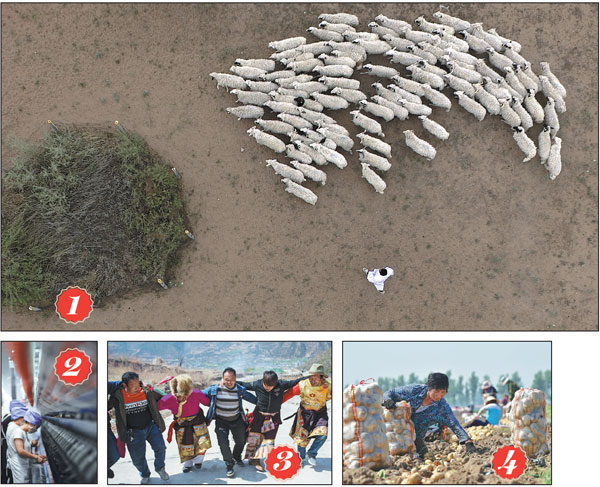Success stories
Four areas where lives have been improved
1. Yanchi, Ningxia Hui autonomous region
Yanchi, a county known for its Tan sheep, a breed noted for its tasty meat and the long staple length of its wool, is lifting many herders out of poverty through a microfinance program called the Tan Sheep Bank. Using sheep as collateral, the bank offers loans to poor farmers looking to expand their operations. The interest rate is nearly zero - a boon for impoverished farmers with limited means of securing development funding. Participants are also eligible for a monthly interest payment of about 3 yuan for each sheep.
2. Guyuan, Ningxia Hui autonomous region
Guyuan is a landlocked city in Northwest China. Many areas feature rolling hills and barren land, a landscape assessed by the UN as being unfit for human habitation. To ensure that residents can access medical services, job opportunities and education, in 1993, the local government launched a massive project that saw 350,000 farmers relocated to a settlement camp near Yinchuan, the regional capital. Homes were built for the newcomers, along with greenhouses to allow them to grow cucumbers and tomatoes on a large scale throughout the year.
3. Diqing, Yunnan province
In the Diqing Tibetan autonomous prefecture, farmers used to grow wheat, corn and buckwheat in highland fields, and were often troubled by harvest failures and financial difficulties. With government aid, farmers were persuaded to switch to planting medicinal herbs, a product that Yunnan is renowned for. Tongle village, a Lisu ethnic community, now boasts more than 160 hectares of medicinal herb plantations with 13 varieties of plants, which have increased villagers' average per capita income by 3,000 yuan ($421) a year.
4. Potato farming
Potatoes are the main crop in many impoverished areas, but farmers have been troubled by pests and disease. To address these problems, researchers from the Chinese Academy of Sciences developed a fertilizer aimed at helping crops absorb more nutrients. The academy also encouraged the use of fungicides to prevent diseases. Shuicheng, a county in the mountains of Guizhou province, is known for a shortage of arable land - the cultivated area per capita being only about 0.1 hectare. When the technologies were introduced, grain output increased by about 70 percent compared with 2017. The academy said these technologies have also been promoted in the Ningxia Hui and Inner Mongolia autonomous regions.
|
1. Feng Huan herds his family’s Tan sheep in Yanchi, Ningxia Hui autonomous region. Wang Peng / Xinhua 2. A textile factory employs many people living on barren land in Guyuan, Ningxia. Feng Kaihua / Xinhua 3. Farmers in the Diqing Tibetan autonomous prefecture, Yunnan province, dance to celebrate being lifted out of poverty. Hu Chao / Xinhua 4. Technology has helped increase the potato harvest in Luanzhou, Hebei province. Yang Shiyao / Xinhua |
(China Daily 09/30/2019 page33)















